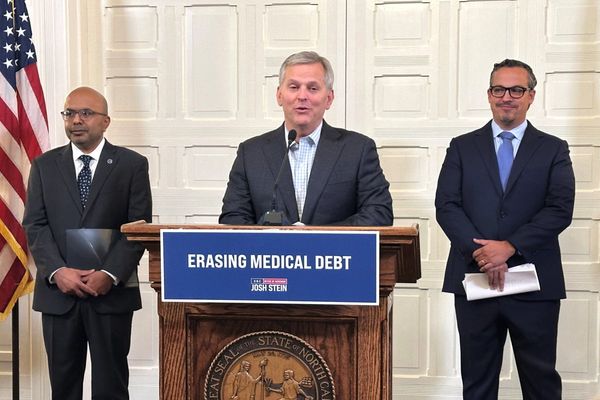A second hawkish Federal Reserve policymaker said Wednesday that he's rethinking the need for more rate hikes amid the surge in the 10-year Treasury yield. If even hawks are thinking that way, then it's pretty clear that the Fed is done hiking. Still, the S&P 500 rally shifted into low gear on Wednesday, trading near the flat line.
10-Year Treasury Yield Does The Fed's Work
The 10-year Treasury yield eased 5 basis points to 4.61% on Wednesday, amid not-so-hawkish comments from Fed Gov. Christopher Waller.
"Financial markets are tightening up and they are going to do some of the work for us," Waller said, alluding to the rise in the 10-year yield. He also highlighted recent progress on inflation, saying that if the trend continues, "we're pretty much back to our target."
Waller's comments came two days after hawkish Dallas Fed President Lorie Logan said "there may be less need to raise the fed funds rate" due to higher long-term interest rates.
Also Wednesday, Fed minutes from the September meeting showed that policymakers expect to keep policy "restrictive" for an extended period. But that generally reinforces expectations that the Federal Reserve will keep rates steady at a high level
S&P 500 Rises As 10-Year Treasury Yield Falls
Wednesday's pullback in the 10-year Treasury bond yield continued a sharp reversal that began Friday morning — after the 10-year yield spiked to a 16-year-high 4.89% on the September employment report's outsize 336,000 job gain.
As the 10-year yield came off its peak, the S&P 500 shifted into rally mode, rising 2.3% and notching three straight gains for the first time since August. But after opening higher on Wednesday, the S&P 500 rally paused, at least for the moment. The S&P edged up 0.1% in afternoon stock market action.
The directionless trend of the S&P 500 on Wednesday may reflect a realization that recent pronouncements by hawkish Fed members aren't necessarily all that bullish.
Yes, it's good news that the Fed will stand pat, because it means less chance that overtightening will trigger a recession. However, the implication from the hawkish policy duo is that the 10-year Treasury yield will have to stay elevated, or the Fed could change its mind.
The upshot is that we probably won't get much more relief from the high 10-year Treasury yield until the economy loses steam and the threat of an inflation reacceleration fades. That may not be a great backdrop for a strong S&P 500 rally.
Friday's turnaround session for the S&P 500 could turn out to be an inflection point, but that's not assured, so investors should still act with prudence. Be sure to read IBD's The Big Picture every day to stay in sync with the market direction and what it means for your trading decisions.
Futures: Indexes At Key Levels With Inflation Data Due
Why Is The 10-Year Treasury Yield Falling?
The pullback in the 10-year Treasury yield on Friday morning came at least partly because the jobs report wasn't quite as strong as initially feared. Average hourly wages rose just 0.2% for a second straight month, while the jobless rate held at 3.8%, instead of falling as expected. Those metrics added to the evidence that the job market is no longer extremely tight.
The war between Israel and Hamas that began with weekend terror attacks may be creating a safety bid for risk-free Treasuries. Plus, there are some signs that high interest rates are curbing the strong consumer spending that had led the Federal Reserve to turn more hawkish. Higher gas prices and renewed student loan payments also may be contributing to a slowdown.
Citigroup said last week that customers' credit card spending at retailers fell nearly 11% in September. Bureau of Economic Analysis data on credit card spending at retailers also indicates a slowdown began in late August.
The 10-year Treasury yield is linked to rates for auto loans and the 30-year fixed-rate mortgage, which is now at 7.6%, according to Mortgage News Daily.
10-Year Treasury Yield: What's Under The Hood?
Dallas Fed President Logan highlighted the reason for the higher 10-year Treasury yield as an important consideration. The level of the 10-year yield compensates bondholders for two things: expected inflation and everything else — such as the risk that bond yields will rise over time, which would lower the value of long-term bonds bought today.
If the 10-year Treasury bond yield were rising in tandem with increasing inflation expectations, the Federal Reserve would have no reason to pause rate hikes. But the opposite has been true.
Lately, bondholders are demanding a bit less compensation for expected inflation, which means that real interest rates have climbed, contributing to tighter financial conditions.
The inflation-compensation portion of the 10-year Treasury yield is known as the 10-year break-even inflation rate. This is derived by subtracting the 10-year TIPS (or Treasury Inflation-Protected Securities) rate from the 10-year Treasury yield. Since July 25, a day before Chair Jerome Powell revealed that Fed staff no longer expected a recession, the 10-year break-even inflation rate has eased to 2.32% from 2.39%.
Meanwhile, the 10-year TIPS rate, which factors out inflation expectations, has jumped to 2.34% from 1.52%. But that's down from 2.47% at Friday's close.
That means markets have slightly reined in expectations for the level of real interest rates that will be needed to sufficiently cool growth and inflation.
Fed QT Adds To Treasury Supply
Asked on Sept. 20 about the rise in Treasury yields, Powell stated flatly: "It's not because of inflation."
Powell highlighted "more supply of Treasuries" and stronger growth as partial explanations. Part of that extra supply comes from Fed quantitative tightening, the unloading of government-backed mortgage securities and Treasuries that the central bank bought early in the pandemic to boost financial market liquidity. The Fed is letting up to $95 billion in bonds run off its balance sheet each month.
In other words, the tighter financial conditions that Waller says will do "some of the work for us" aren't just a coincidence but part of the Fed's plan.







